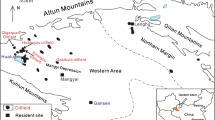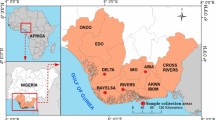Abstract
Three sulphur-rich commercial crude oils have been studied, which contain sulphur as high as up to 4–12%. These samples were collected from Tertiary hypersaline lake sediments of the Jianghan Basin, Hubei Province at different depths, but above the oil generation threshold (2200m). FPD-GC and GC-MS data show that aromatic fractions of the crude oils are composed of different homologues of sulphur-containing compounds, including long-chain normal alkyl-thiophenes and-thiolanes, long-chain isoprenoid-thiophenes and -thiolanes, and benzothiophenes. It is worth noting that the distribution patterns of long-chain alkyl-thiophenes and -thiolanes from two shallow-seated crude oils are quite similar to those of normal alkanes showing marked even-odd predominance. It seems that the even-odd predominance of sulphur-containing compounds decreases with increasing burial depth of the crude oils. The major component of aliphatic fraction is phytane, and similarly the major peaks of aromatic fractions also represent C20 isoprenoid thiophenes.
Some preliminary conclusions have been drawn from the above discussion: (1) Abundant sulphur-containing compounds may be used as an indicator of low mature or immature crude oils produced from hypersaline lake sediments; (2) Sulphur-containing compounds are considered to be early diagenetic products of reactions between elemental sulphur or sulfides and alkanes or their precursors (phytols, fatty acids, alcohols, etc.), or of bacterial activities, but not direct inputs of organisms.
Similar content being viewed by others
References
Wilson L. Orr,Oil Sand and Oil Shale Chemistry (edited by Strausz O.P. and Lown E.M.), 1978, 223–243. Verlag Chemie Int., New York.
Sinninghe Damste J.S. et al.,Advances in Organic Geochemistry (1985) (Editors: D.Leythaeuser and J.Rüllkötter), 10(1986), 791–806.
Ocampo R., Callot H., Valisolalao J., Schmid J.C., Connan J. and Albrecht P.,Organic Geochemistry, 10(1986), Sheng Guoying, Fu Jiamo, Brassell S.C., Eglinton G. and Jiang Jigang, 2(1986), 138–145.
Sheng Guoying, Fu Jiamo, Brassell S.C., Eglinton G., Jiang Jigang and Liang Digang,Scientia Sinica (in press).
Sinninghe Damste J.S. and de Leeuw J.W., presented at the 3rd Workshop on Chemistry and Analysis of Hydrocarbons in the Environment, Lausanne, 1986.
Fu Jiamo et al.,Advances in Organic Geochemistry (1985) (Editors: D.Leythaeuser and J.Rüllkötter), 10(1986), 119–126.
Author information
Authors and Affiliations
Rights and permissions
About this article
Cite this article
Sheng, G., Fu, J., Brassell, S.C. et al. Sulphur-containing compounds in sulphur-rich crude oils from hypersaline lake sediments and their geochemical implications. Chin. J. of Geochem. 6, 115–126 (1987). https://doi.org/10.1007/BF02872213
Issue Date:
DOI: https://doi.org/10.1007/BF02872213




